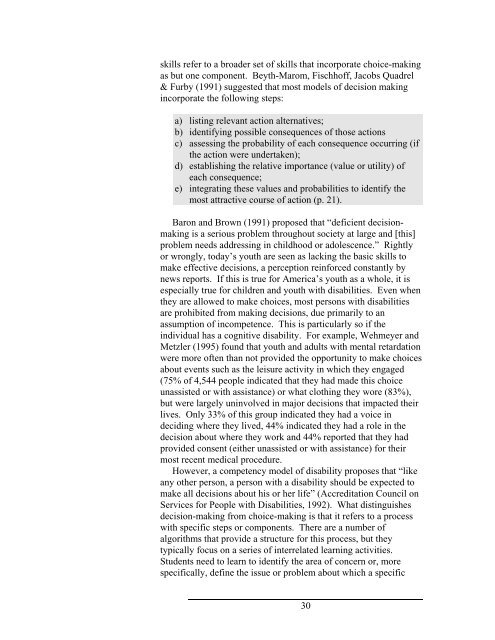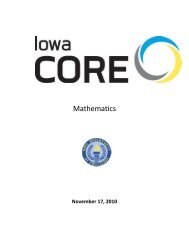The Arc's Self-Determination Scale: Procedural Guidelines
The Arc's Self-Determination Scale: Procedural Guidelines
The Arc's Self-Determination Scale: Procedural Guidelines
You also want an ePaper? Increase the reach of your titles
YUMPU automatically turns print PDFs into web optimized ePapers that Google loves.
skills refer to a broader set of skills that incorporate choice-making<br />
as but one component. Beyth-Marom, Fischhoff, Jacobs Quadrel<br />
& Furby (1991) suggested that most models of decision making<br />
incorporate the following steps:<br />
a) listing relevant action alternatives;<br />
b) identifying possible consequences of those actions<br />
c) assessing the probability of each consequence occurring (if<br />
the action were undertaken);<br />
d) establishing the relative importance (value or utility) of<br />
each consequence;<br />
e) integrating these values and probabilities to identify the<br />
most attractive course of action (p. 21).<br />
Baron and Brown (1991) proposed that “deficient decisionmaking<br />
is a serious problem throughout society at large and [this]<br />
problem needs addressing in childhood or adolescence.” Rightly<br />
or wrongly, today’s youth are seen as lacking the basic skills to<br />
make effective decisions, a perception reinforced constantly by<br />
news reports. If this is true for America’s youth as a whole, it is<br />
especially true for children and youth with disabilities. Even when<br />
they are allowed to make choices, most persons with disabilities<br />
are prohibited from making decisions, due primarily to an<br />
assumption of incompetence. This is particularly so if the<br />
individual has a cognitive disability. For example, Wehmeyer and<br />
Metzler (1995) found that youth and adults with mental retardation<br />
were more often than not provided the opportunity to make choices<br />
about events such as the leisure activity in which they engaged<br />
(75% of 4,544 people indicated that they had made this choice<br />
unassisted or with assistance) or what clothing they wore (83%),<br />
but were largely uninvolved in major decisions that impacted their<br />
lives. Only 33% of this group indicated they had a voice in<br />
deciding where they lived, 44% indicated they had a role in the<br />
decision about where they work and 44% reported that they had<br />
provided consent (either unassisted or with assistance) for their<br />
most recent medical procedure.<br />
However, a competency model of disability proposes that “like<br />
any other person, a person with a disability should be expected to<br />
make all decisions about his or her life” (Accreditation Council on<br />
Services for People with Disabilities, 1992). What distinguishes<br />
decision-making from choice-making is that it refers to a process<br />
with specific steps or components. <strong>The</strong>re are a number of<br />
algorithms that provide a structure for this process, but they<br />
typically focus on a series of interrelated learning activities.<br />
Students need to learn to identify the area of concern or, more<br />
specifically, define the issue or problem about which a specific<br />
30
















